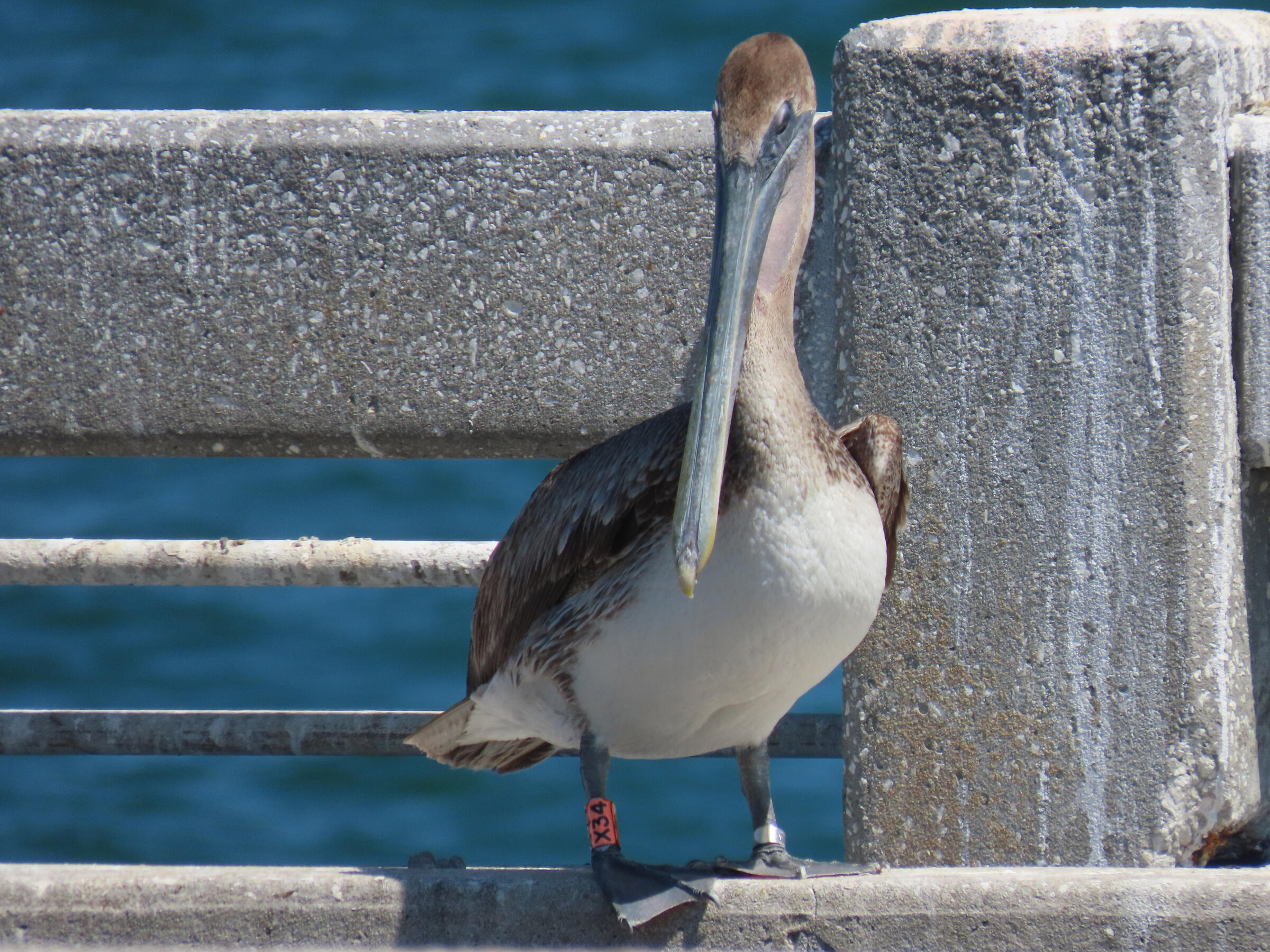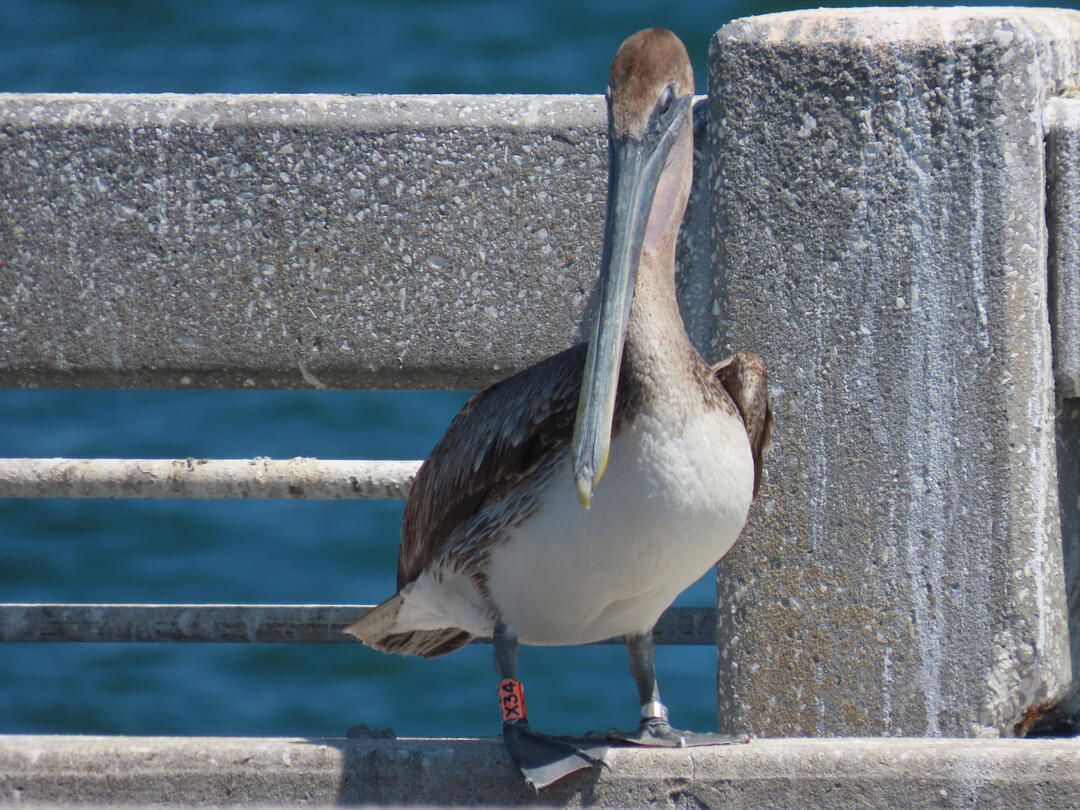Whether gliding low over the water, diving headfirst into a school of unsuspecting fish or loafing on a dock, Brown Pelicans are icons of Tampa Bay and southwest Florida. Like many Floridians and the millions of visitors that we welcome each year, Brown Pelicans can frequently be seen fishing along our shores. Unfortunately, these birds are often hooked by recreational anglers and sometimes become entangled in improperly discarded fishing gear.
Fishing gear, such as monofilament or braided fishing lines, hooks, and lures, poses a threat to Brown Pelicans and other wildlife. If these hazards are left in the environment, birds can become entangled and often die as a result. Additionally, Brown Pelicans are inadvertently hooked by recreational anglers, who often do not know that just cutting the line isn't the best response.
Luckily, Audubon chapters have developed an informational video for recreational anglers with information on what to do if they hook a bird.
Tampa Audubon Society, St. Petersburg Audubon Society, and Manatee County Audubon Society worked with videographer Dee Fairbanks Simpson to produce this short film describing the danger of fishing gear to birds, especially Brown Pelicans.
Responsible anglers know that they should not just cut the line to rescue the bird. Instead, they reel in the bird and remove the hook. If line is accidentally snagged on something, it is important to clear the gear so that it doesn’t entangle wildlife.
When a pelican is hooked and the line is cut, the trailing end of the line will often become entangled in mangroves where pelicans roost and nest. Helpless pelicans are often tethered to the tree, where they remain until they eventually succumb to dehydration. Unfortunately, the harm doesn’t always end there; the fishing line remains in the environment for many years, and can repeatedly entangle and kill birds if left in place.
Audubon’s Florida Coastal Islands Sanctuaries partners with Tampa Bay Watch and Sarasota Bay Watch each fall to remove monofilament and fishing gear from dozens of important nesting and roosting sites throughout Pinellas, Hillsborough, Manatee, and Sarasota Counties in Southwest Florida. We remove thousands of feet of line each year!
Audubon Florida has initiated a research project to investigate how hooking and entanglement are impacting Brown Pelican populations in southwest Florida, including Tampa Bay. We are banding a portion of the pelicans that are rescued and healthy for release. The goal of this project is to understand how pelicans are interacting with recreational fisheries, what impact that is having on their population, and what steps we can take to reduce the negative impacts on Brown Pelicans.
This project is all about collaboration. Audubon wants to acknowledge our partners: Project funding provided by the Community Foundation of Sarasota County. Additionally, our work would not be possible without the Seaside Seabird Sanctuary and Save Our Seabirds. Thank you to our partners, as well as numerous community members who have reported sightings of banded birds.
Why are the birds banded?
Each bird is given a unique identifier that allows researchers to better understand the fate of an individual in the population. Whenever that bird is seen and its code reported, we have an additional piece of data on that bird, which allows researchers to understand the population-level processes such as survival rates, migration, and site-fidelity. The bands are field-readable, which allows us to gather data on the bird without ever having to recapture it.
Can banding harm the bird?
Banding is a long-established research technique that does not adversely affect the birds when done by a trained professional. Our project has both federal and state permits to conduct the research, and the bands are custom-made for Brown Pelicans.
What information can banding provide?
Lots! Banding gives us insight into the story of an individual pelican’s life, and collectively, how a population is faring. Banding helps us understand how long birds are living, how they are dying, where they move throughout the year, what locations are important to them, and how they are impacted by human activities, such as recreational fishing. From banding studies, researchers have discovered that Brown Pelicans can live for 40 years in the wild! Stay tuned for updates on what we are learning from this project.
What should I do if I accidentally hook a bird?
Just like you would do with a fish, reel it in, remove the hook, and release it. The best method is to cut off the barbed tip of the hook and then back the hook out. If the bird is seriously injured, please take it to a certified wildlife rehabber in your area.
How can I help?
Keep a lookout for banded birds! If you spot a Brown Pelican with an ORANGE leg band, report it here! If you see a Brown Pelican with a leg band of any other color, please report it to the Bird Banding Lab.
Additionally, please be a responsible angler. To help keep pelicans and other birds safe, please:
- Reel in caught birds, cut the barb off the hook, and back the hook out.
- Remove the hook and line from trees or other objects that it gets snagged on.
- Do not feed birds bait - doing so trains the birds to associate people with food, and that puts them at greater risk of becoming hooked.
- Do not feed birds fileted carcasses - the carcass provides little sustenance and exposed bones easily become embedded in the pelican's throat if they try to swallow it.
How you can help, right now
Donate to Audubon
Help secure the future for birds at risk from climate change, habitat loss and other threats. Your support will power our science, education, advocacy and on-the-ground conservation efforts.
Become a Monthly Donor
Donating monthly is flexible, easy and convenient and makes you a champion birds can count on, no matter the season.
Volunteers Needed
Florida's birds and wildlife need your time and energy. Learn how you can become a citizen scientist or a volunteer at one of our nature centers today.





